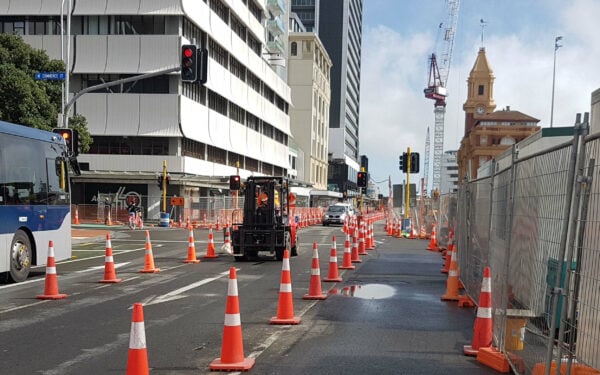Roads have more uncontrolled dangers than warehouses and factories when it comes to operating a forklift. For this reason, forklift operators must hold both an F endorsement and operator’s certificate, plus the right class of licence (class 1 for forklifts with a gross vehicle mass under 18000kg, and class 2 if the GVM is 18000kg or over.)
Bear in mind that NZTA’s definition of a road is very broad (it includes bridges, wharves, footpaths, the verge, and more).
What do you need on your forklift?
Because you must follow the Road Code, your forklift will need to have the same as a roadgoing vehicle: a current registration, warrant of fitness, and working lights, indicators and horn. A flashing beacon light on the top also helps with visibility. If wide loads are carried, then oversized load panels must be displayed.
Your forklift also must be capable of handling slightly uneven surfaces. Many forklifts have totally smooth tyres and minimal ground clearance and can only be used on a perfectly flat surface, like in a warehouse. Forklifts that are used on the road should have grooved tyres.

A forklift makes its way down a coned lane during roadworks in Auckland
What makes driving on a road more dangerous than driving in a warehouse?
Lack of separation
In a warehouse, pedestrians and other vehicles can be kept separate from forklifts, whereas on the road a forklift is in the vehicle lane, often not able to keep up with general traffic flow because of a lower top speed.
When crossing the pathway, cones and barriers can provide some separation for pedestrians, scooter riders and others, but they are not always paying attention.
Weather and visibility
The weather affects both the forklift and the operator:
- Too hot: operators can become dehydrated, which affects reaction time
- Too cold: operators can get numb fingers which decreases their fine muscle control when operating the controls. In worse cases, operators can get hypothermia which affects reaction time.
- Too windy: strong winds push against whatever the forklift is carrying. If the forklift has to lift it high, the wind can put enough force on the item to put it at risk of either falling off the forks or toppling the forklift
- Too slippery: snow, ice and water all make the surface more slippery, meaning it’s harder to stop or manoeuvre.
- Too bright: sun strike can make visibility challenging, especially when lifting.
- Too gloomy: low light levels make it tricky for other vehicles to see your forklift; use lights and flashing beacons. It also makes it harder to see what you are lifting and where you are lifting too.
- Too wet: for forklifts without a cab, an operator can get very wet, which is distracting. For forklifts with a cab, ineffective window wipers might make it difficult for you to see out. When there are a lot of puddles, you don’t know whether a puddle is concealing a deep pothole.
Other road users
Unladen forks (i.e. forks with no load) are very difficult to see, especially in low light. Many accidents between forklifts and other road users involve them driving, riding or walking into the forks because they didn’t see them.
Remember to keep your forks low when travelling, and keep your lights on. When parked, the forks should be placed on the ground.
Assume that other road users have not seen you and are unaware of the difference in speed, and that your forklift will steer from the rear.
Uneven surfaces
Three types of uneven surfaces are an issue for forklifts:
- Camber is the slope of the road towards the gutter. This can cause an issue when driving off a footpath onto a road – the forks are more likely to hit the road, so care has to be taken. It also means that when the forklift is travelling along the road, it’s leaning slightly towards the edge of the road. This isn’t usually a problem, but bumps in the road can start to bounce the load off the forks.
- Kerbs are the interface between the road and the footpath. Even a low kerb can cause quite a bump. They need to be driven over at slow speeds. There are times when you will cross them diagonally, and times when you are more likely to cross them straight on (e.g. when carrying a very wide load). Don’t hit kerbs at speed because forklifts don’t have suspension.
- Potholes, speed bumps, drains, manhole covers, cat’s eyes and other variations in the flatness of the road can cause significant problems. A deep pothole can easily cause a forklift to tip over and/or lose its load.
What is some succinct advice for driving a forklift on the road?
- Make sure you have an F endorsement
- Obey the Road Code – indicate when you are turning, drive on the left, etc
- Keep left so that others can overtake you – your forklift won’t usually be as fast as regular traffic
- Keep speeds low due to the variation in surface flatness
- If the weather or visibility is poor, it’s best to wait for conditions to improve
- If possible, use cones or barriers to mark out the work area and keep other road users out
- Get someone to help you if traffic is making it difficult to manoeuvre – for example, a spotter or traffic controller
- Use flashing beacons, your headlights and hi-vis clothing to help remain visible
- Assume that you are invisible and that no other road user has seen you.

